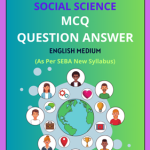SEBA Class 6 Social Science MCQ Chapter 2 The Shape and The Size of The Earth Solutions in English Medium, Class 6 Social Science Multiple Choice Question Answer to each chapter is provided in the list so that you can easily browse throughout different chapters SEBA Class 6 Social Science MCQ Chapter 2 The Shape and The Size of The Earth Question Answer and select need one.
SEBA Class 6 Social Science MCQ Chapter 2 The Shape and The Size of The Earth
Also, you can read the SCERT book online in these sections SEBA Class 6 Social Science Objective Type Solutions by Expert Teachers as per SCERT (CBSE) Book guidelines. These solutions are part of SCERT All Subject Solutions. Here we have given Assam SEBA Class 6 Social Science MCQ Solutions for All Subject, You can practice these here.
The Shape and The Size of The Earth
Chapter – 2
| MCQ |
1. What is the approximate circumference of the Earth at the equator?
(a) 30,000 km.
(b) 40,000 km.
(c) 50,000 km.
(d) 60,000 km.
Answer: (b) 40,000 km.
2. The Earth is not a perfect sphere but is slightly flattened at the:
(a) Equator.
(b) Poles.
(c) Tropics.
(d) Prime Meridian.
Answer: (b) Poles.
3. The concept that the Earth is an oblate spheroid was proposed by:
(a) Ptolemy.
(b) Aristotle.
(c) Newton.
(d) Galileo.
Answer: (c) Newton.
4. Which of the following best describes the shape of the Earth?
(a) Geoid.
(b) Cylinder.
(c) Cube.
(d) Pyramid.
Answer: (a) Geoid.
5. The distance from the Earth’s centre to its surface is greater at the:
(a) Equator.
(b) Poles.
(c) Tropics.
(d) Prime Meridian.
Answer: (a) Equator.
6. Which instrument helped in proving the Earth’s spherical shape?
(a) Sextant.
(b) Telescope.
(c) Compass.
(d) Satellite.
Answer: (d) Satellite.
7. The Earth’s diameter is approximately:
(a) 6,371 km.
(b) 12,742 km.
(c) 10,000 km.
(d) 15,000 km.
Answer: (b) 12,742 km.
8. The difference between the Earth’s equatorial and polar diameters is about:
(a) 42 km.
(b) 84 km.
(c) 127 km.
(d) 220 km.
Answer: (c) 127 km.
9. Who was the first person to propose that the Earth is round?
(a) Aristotle.
(b) Ptolemy.
(c) Copernicus.
(d) Magellan.
Answer: (a) Aristotle.
10. Which explorer’s voyage provided practical evidence for the Earth’s roundness?
(a) Christopher Columbus.
(b) Ferdinand Magellan.
(c) Vasco da Gama.
(d) Marco Polo.
Answer: (b) Ferdinand Magellan.
11. What phenomenon can be observed during a lunar eclipse that indicates the Earth’s shape?
(a) Earth’s shadow on the Moon.
(b) Movement of the Moon.
(c) Brightness of the Moon.
(d) Color of the Moon.
Answer: (a) Earth’s shadow on the Moon.
12. What is the approximate age of the Earth?
(a) 2.5 billion years.
(b) 4.5 billion years.
(c) 6.5 billion years.
(d) 8.5 billion years.
Answer: (b) 4.5 billion years.
13. The Earth’s shape causes variations in:
(a) Gravity.
(b) Climate.
(c) Population density.
(d) Vegetation.
Answer: (a) Gravity.
14. The Earth’s surface is covered by approximately how much water?
(a) 51%
(b) 61%
(c) 71%
(d) 81%
Answer: (c) 71%
15. The highest point on Earth, Mount Everest, is located in which mountain range?
(a) Andes.
(b) Rockies.
(c) Alps.
(d) Himalayas.
Answer: (d) Himalayas.

Hi! my Name is Parimal Roy. I have completed my Bachelor’s degree in Philosophy (B.A.) from Silapathar General College. Currently, I am working as an HR Manager at Dev Library. It is a website that provides study materials for students from Class 3 to 12, including SCERT and NCERT notes. It also offers resources for BA, B.Com, B.Sc, and Computer Science, along with postgraduate notes. Besides study materials, the website has novels, eBooks, health and finance articles, biographies, quotes, and more.




